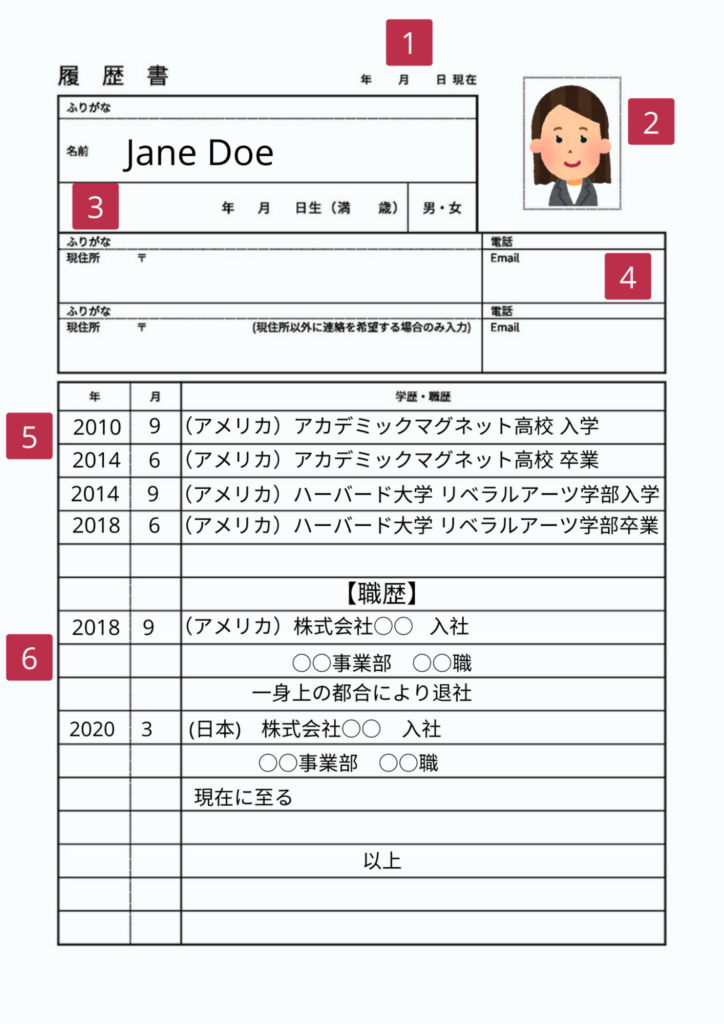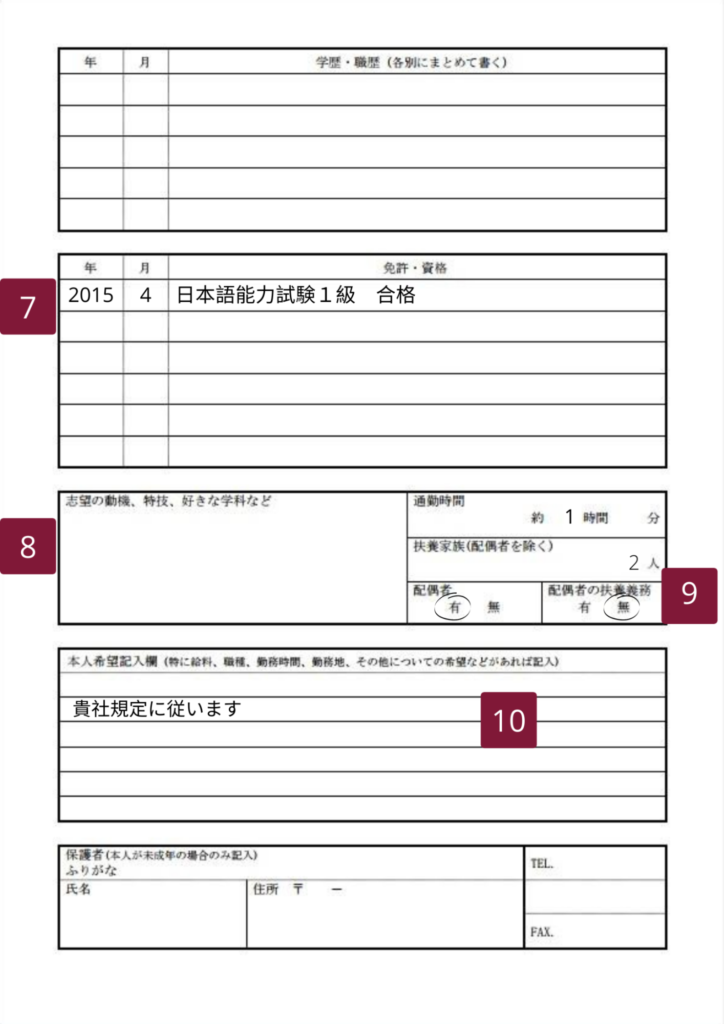Traditionally, there are two types of Japanese resume formats: the basic resume Rirekisho(履歴書), and the so-called second resume, the Shokumukeirekisho(職務経歴書). The first, the Rirekisho, is used to provide basic information about yourself. The second resume, the Shokumukeirekisho, lets you go into detail about yourself, your past experiences, and your achievements. Let’s take a closer look at:
- Resume 1: The Rirekisho
- Resume 2: the Shokumukeirekisho
To Write Or To Type?
Japan is a country that appreciates tradition, and resumes are no different. It is still not uncommon to handwrite your resume, and in fact, some employees look at your handwriting and neatness as part of the vetting process. Although electronic resumes are becoming increasingly common, you may still need to handwrite them, depending on how conservative the company you are applying for is.
Resume 1: The Rirekisho
The Rirekisho is, essentially, a basic overview of your skills and experiences. It is separated into two pages – one for your personal information, educational background and work experience. The second page allows you to further promote yourself and state why you’re interested in the company you’re applying to.
Rirekisho Page 1

Let’s start by looking at the first page, featuring your basic information, like:
1. The Date Of Submission
2. The Photo
3. Your Date Of Birth (Seinengappi 生年月日)
4. E-mail address (Mēruadoresu メールアドレス)
5. Your Academic Background (Gakureki 学歴)
6. Your Work Experience (Shokureki 職歴)
1. The Date of Submission
On the top right corner of your resume, there is a section where you can write the submission date. Be sure to confirm that the information on your resume is the most recent by inputting the same day you apply. Sending a resume you wrote a year or even a few months ago will leave a bad impression and decrease your chances of getting an interview.
2. The Photo
In many countries, putting a photo on your CV is optional, but in Japan, it is extremely important.
The photo should look like you during the interview: professional, well-groomed, and confident. Try to wear a suit (black or navy), a white shirt, and a tie for men. Women can of course put on some makeup, but try to keep it as natural as possible. Avoid flashy jewelry and accessories. However, you can keep your glasses on if you regularly wear them. You can also smile slightly, but don’t show your teeth.
Since a specific format is expected, it’s recommended to use a photo booth. You can find these everywhere – in train stations, convenience stores, or shopping centers. These photo booths usually have guidelines for taking resume photos, so it can be pretty helpful.
We help freelancers
With World in Freelance, you can find:
- Fully remote options – Work anywhere you want.
- Passion projects – Spend time on what inspires and excites you.
- Japanese language upkeep – Team up with top Japanese tech companies.
3. Your Date of Birth (Seinengappi 生年月日)
Different countries, of course, use different formats for dates. In Japan, you have to start with the year and finish with the day. For example, if you were born on October 2nd, 1990, you should write 1990.10.02. Also note that depending on the format of your resume, you might have to use the Japanese calendar. It is most likely that you were born during the Showa era(Showa 昭和 1926 – 1988)or the Heisei era(Heisei 平成 1989 – 2019). For example, October 2nd 1990 will be H2.10.02 (Heisei 2.10.02). You can find a handy converter here.
4. E-mail Address (Mēruadoresu メールアドレス)
For modern job applications, an email address is essential. Be sure to use a professional address, and avoid something casual or humorous. As a rule, name.surname@gmail.com is the safest way to go.
5. Your Academic Background (Gakureki 学歴)
Provide your academic record starting from high school onwards. If you studied outside Japan, don’t forget to indicate the country. Include the year of your entrance, and the year of graduation. Don’t forget to add your faculty and your major for tertiary education.
6. Your Work Experience (Shokureki 職歴)
Education and work experience is in the same section, so once you’ve finished writing your education, leave some space and start with work experience (Shokureki 職歴) to show you will be moving on to employment history. Doing it in chronological order is best.
Write the company’s official name and add “joined the company” (Nyūsha 入社) in the first line. Then, in the next line, write your department and your position. Finally, go to the next line to indicate whether you are still at the company or if you have left it. If you are still working there, write “until present” (Genzai ni itaru 現在に至る), if not, write the date you left the company (Taisha 退社) and the reason.
There are a few reasons you can provide for leaving a company. The most common are:
- for personal reasons (Isshinjō no tsugō ni yori taisha 一身上の都合により退社)
- involuntary resignation (Kaisha tsugō ni yori taisha 会社都合により退社)
- if your contract has ended (Keiyaku kikan shūryō ni tsuki taishoku 契約期間終了につき退職)
Japanese companies will look at the number of times you have changed jobs (Tenshoku kaisū 転職回数), and candidates considered “job-hoppers” will struggle to land an interview. If you have changed jobs more than once in a short period of time, be sure to stipulate why, and be ready to talk about it during the interview. If the reason written on your resume is always for personal reasons, or so-called involuntary resignation (being let go), it won’t look good.
Rirekisho Page 2

The second page is for sharing additional qualifications, motivation for applying, and expectations of the job under sections such as:
7. Other diplomas and certificates (Menkyo 免許・Shikaku 資格)
8. Your Motivations And Self-Promotion (Shibō dōki 志望動機、jiko PR 自己PR)
9. Commute Time (Tsūkin jikan 通勤時間), Dependents (Fuyō kazoku – haigūsha o nozoku 扶養家族 – 配偶者を除く), Spouse (Haigūsha 配偶者), And Obligation To Support Your Spouse (Haigūsha no fuyō gimu 配偶者の扶養義務)
10. Personal Requests
7. Other Diplomas and Certificates (Menkyo 免許・Shikaku 資格)
In this field, you can write any licenses or qualifications you have, including your driver’s license. Please be sure to write the certificate’s official name and enter the acquisition year correctly. If you don’t have any, you can write “none in particular” (Tokuninashi 特になし) in the first line.
8. Your Motivations and Self-Promotion (Shibō Dōki 志望動機、Jiko PR 自己PR)
Depending on the format, this field will be small, but it is still very important. This is your chance to state what motivated you to apply for the job, what your strengths are, and how they are linked to the job description. To summarize, this is the perfect field to sell yourself and show why the company should hire you. Be sure to personalize it for each company and job description.
9. Commute Time (Tsūkin Jikan 通勤時間), Dependents (Fuyō Kazoku – Haigūsha o Nozoku 扶養家族 – 配偶者を除く), Spouse (Haigūsha 配偶者), and Obligation to Support Your Spouse (Haigūsha No Fuyō Gimu 配偶者の扶養義務)
・Commute time: In this section, enter the duration of your commute. It is common to write “About 30 minutes” (Yaku San-Jiu bu 約30分) or “up to 1 hour“(Ichi-jikan inai 1時間以内).
・Dependants (excluding spouse): Write how many people other than your spouse are supported by your income. For example, if you are married and have two children, you should write 2. Note that if your children are already working, they will not be included as dependents.
・Spouse: Circle yes (Yū 有) or no (Mu 無) to indicate your marital status.
・Dependents: This includes all family members you support financially. The reason for listing this information is that the company will use it when calculating income taxes and applying for social and health insurance.
10. Personal Requests
You can write your work preferences in this section (location, salary, etc.) but it’s okay to leave it blank or to write “according to your company’s regulations” (Kisha kitei ni 貴社規定に). This is also a good space to include your availability for interviews.
The Rirekisho may seem different from what you are used to, but being able to write it correctly as a foreigner will leave a good impression. Even though the Rirekisho doesn’t require a lot of information, there are still some common mistakes that could reduce your chances of getting an interview. Be sure to follow the tips, and don’t hesitate to contact one of our friendly career advisors here if you need more help.

Resume 2: The Shokumukeirekisho
The Shokumukeirekisho is generally more complicated than the Rirekisho. Its goal is to expand upon the Rirekisho and give more details about your work experience. It is your chance to really highlight all your skills and achievements that you may not have been able to include in the Rirekisho. For a closer look, read our article on the Shokumukeirekisho here. Once you have aced writing both the Rirekisho and The Shokumukeirekisho, use them to apply for your dream job on our job board.
Looking For Guidance?
Inbound Technology is here to help. Chat with one of our knowledgeable career advisors here, or follow us on LinkedIn.
